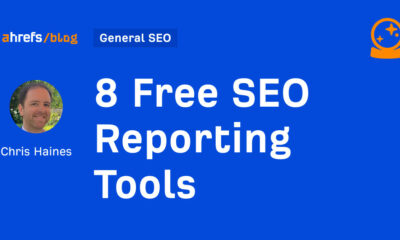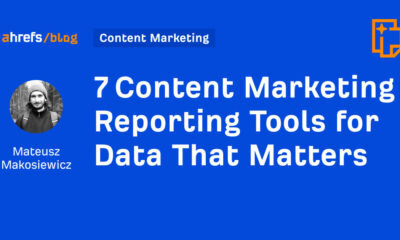SEO
Google Debuts Upgrades To Its Enterprise 360 Suite Tools
If you’re an enterprise-level marketer, it can be tough to operate and scale ad campaigns.
You’ve also likely heard, and maybe are even using, Google’s enterprise suite of tools like Display & Video 360 (DV360) and Campaign Manager 360.
Google announced during its annual Google Marketing Live Summit that it’s enhancing the platforms to enable you for a privacy-first future, while growing your business through new ad formats.
Eduardo Indacochea, Sr. Director, Product Management of Google, kicked off this session to discuss the importance of these tools for enterprise marketers.
With 39% of advertisers expecting an increase in their programmatic spend in the next 12 months, these solutions provide a better experience for both consumers and advertisers.
Indacochea laid out the plan for the 360 Suite tools:
- New form of ads for Connected TV (CTV)
- Machine learning and automation updates
- New privacy-safe signals
Let’s dig into the details of the three-tiered plan from Google.
New Ad Formats
Chaoyi Chen, Global Product Lead, DV360 Platform Strategy for Google, broke down the three key areas of expansion for DV360. They include:
- Audio ad updates
- Connected TV
- Unified tools
Audio Ads
Podcasting has become all the rage in the past few years. Because of this, Google will soon be launching podcast targeting on YouTube and partner inventory.
Another update coming to audio ads is the expansion of targeting. More podcast genres and inventory will soon be available on Display & Video 360.
Connected TV
Chen reinforced just how many people are turning to YouTube for a connected TV experience. In fact, YouTube reached 135 million users in December of 2021.
More broadcasts and publishers will be joining the DV360 inventory in the future. Peacock is the latest publisher to be added to the inventory.
With DV360 reaching 93% of ad-supported CTV households in the United States, Google is extending its Google audiences to Connected TV devices. Additionally, demographic segments will be available to the platform by end of Q2 2022.
Unified Reporting Tools
Google understands the importance of identifying performance across YouTube versus other linear networks. That’s why Google is launching a new co-viewing planning and measurement tool.
Currently, this tool is in beta for certain customers. The broad rollout to additional advertisers will come this fall of 2022.
You’ll now be able to effectively manage all your publisher deals in one place. You have the ability to create one deal and distribute impressions across different accounts and publishers.
Lastly, you can control and manage your brand safety in Campaign Manager 360.
“Buying TV ads should be as easy as watching TV”, Chen states. These updates will help simplify your planning and management of publisher deals.
Machine Learning Updates
Being able to combine automation with customization is the ultimate key to success with Google.
Google announced its latest custom bidding signals you can choose from, such as player size and audibility. Additional bidding signals help you customize and maximize your ROI based on your business goals.
With the move from Universal Analytics to Google Analytics 4 properties, your GA4 properties can now be activated in Display & Video 360 immediately.
Privacy-Safe Signals
Google has prepared us for the deprecation of third-party cookies. It seems Google has taken advertiser feedback into consideration while making these enhancements.
If you’re currently using interest-based advertising options from Google, these will now incorporate topics from its new API sandbox coming soon.
The biggest update comes in the form of EPIDs: Exchange Provided Identifiers. These IDs are shared by exchanges or publishers with DV360. They are scoped on a domain or app-basis. The EPIDs will then be used to build segments for advertisers to use.
The last update for privacy-safe signals is the ability to match first-party data for marketing use. Google will allow a direct relationship between the advertiser and publisher to share data.
It’s important to note that no personal identifiable information (PII) will ever be shared between the two. All data will be encrypted, making user identity safe and advertisers still have the ability to reach its target audience.
Summary
We live in a fast-paced world. That’s not changing.
Now is the time to explore more advertising environments, especially if you’re in the enterprise space.
By utilizing DV360 and Campaign Manager 360, you can streamline your planning, process, and management of campaigns. This saves you time, efficiency, and money.
New ad formats will make it easier than ever to test out reaching your target audience in places you haven’t before. More importantly, DV360 will make it easier to scale and monetize your performance.
Source: Google Marketing Live
Featured Image: BestForBest/Shutterstock
!function(f,b,e,v,n,t,s)
{if(f.fbq)return;n=f.fbq=function(){n.callMethod?
n.callMethod.apply(n,arguments):n.queue.push(arguments)};
if(!f._fbq)f._fbq=n;n.push=n;n.loaded=!0;n.version=’2.0′;
n.queue=[];t=b.createElement(e);t.async=!0;
t.src=v;s=b.getElementsByTagName(e)[0];
s.parentNode.insertBefore(t,s)}(window,document,’script’,
‘https://connect.facebook.net/en_US/fbevents.js’);
if( typeof sopp !== “undefined” && sopp === ‘yes’ ){
fbq(‘dataProcessingOptions’, [‘LDU’], 1, 1000);
}else{
fbq(‘dataProcessingOptions’, []);
}
fbq(‘init’, ‘1321385257908563’);
fbq(‘track’, ‘PageView’);
fbq(‘trackSingle’, ‘1321385257908563’, ‘ViewContent’, {
content_name: ‘google-debuts-upgrades-to-its-enterprise-360-suite-tools’,
content_category: ‘news programmatic’
});
SEO
Google March 2024 Core Update Officially Completed A Week Ago

Google has officially completed its March 2024 Core Update, ending over a month of ranking volatility across the web.
However, Google didn’t confirm the rollout’s conclusion on its data anomaly page until April 26—a whole week after the update was completed on April 19.
Many in the SEO community had been speculating for days about whether the turbulent update had wrapped up.
The delayed transparency exemplifies Google’s communication issues with publishers and the need for clarity during core updates
Google March 2024 Core Update Timeline & Status
First announced on March 5, the core algorithm update is complete as of April 19. It took 45 days to complete.
Unlike more routine core refreshes, Google warned this one was more complex.
Google’s documentation reads:
“As this is a complex update, the rollout may take up to a month. It’s likely there will be more fluctuations in rankings than with a regular core update, as different systems get fully updated and reinforce each other.”
The aftershocks were tangible, with some websites reporting losses of over 60% of their organic search traffic, according to data from industry observers.
The ripple effects also led to the deindexing of hundreds of sites that were allegedly violating Google’s guidelines.
Addressing Manipulation Attempts
In its official guidance, Google highlighted the criteria it looks for when targeting link spam and manipulation attempts:
- Creating “low-value content” purely to garner manipulative links and inflate rankings.
- Links intended to boost sites’ rankings artificially, including manipulative outgoing links.
- The “repurposing” of expired domains with radically different content to game search visibility.
The updated guidelines warn:
“Any links that are intended to manipulate rankings in Google Search results may be considered link spam. This includes any behavior that manipulates links to your site or outgoing links from your site.”
John Mueller, a Search Advocate at Google, responded to the turbulence by advising publishers not to make rash changes while the core update was ongoing.
However, he suggested sites could proactively fix issues like unnatural paid links.
“If you have noticed things that are worth improving on your site, I’d go ahead and get things done. The idea is not to make changes just for search engines, right? Your users will be happy if you can make things better even if search engines haven’t updated their view of your site yet.”
Emphasizing Quality Over Links
The core update made notable changes to how Google ranks websites.
Most significantly, Google reduced the importance of links in determining a website’s ranking.
In contrast to the description of links as “an important factor in determining relevancy,” Google’s updated spam policies stripped away the “important” designation, simply calling links “a factor.”
This change aligns with Google’s Gary Illyes’ statements that links aren’t among the top three most influential ranking signals.
Instead, Google is giving more weight to quality, credibility, and substantive content.
Consequently, long-running campaigns favoring low-quality link acquisition and keyword optimizations have been demoted.
With the update complete, SEOs and publishers are left to audit their strategies and websites to ensure alignment with Google’s new perspective on ranking.
Core Update Feedback
Google has opened a ranking feedback form related to this core update.
You can use this form until May 31 to provide feedback to Google’s Search team about any issues noticed after the core update.
While the feedback provided won’t be used to make changes for specific queries or websites, Google says it may help inform general improvements to its search ranking systems for future updates.
Google also updated its help documentation on “Debugging drops in Google Search traffic” to help people understand ranking changes after a core update.
Featured Image: Rohit-Tripathi/Shutterstock
FAQ
After the update, what steps should websites take to align with Google’s new ranking criteria?
After Google’s March 2024 Core Update, websites should:
- Improve the quality, trustworthiness, and depth of their website content.
- Stop heavily focusing on getting as many links as possible and prioritize relevant, high-quality links instead.
- Fix any shady or spam-like SEO tactics on their sites.
- Carefully review their SEO strategies to ensure they follow Google’s new guidelines.
SEO
Google Declares It The “Gemini Era” As Revenue Grows 15%

Alphabet Inc., Google’s parent company, announced its first quarter 2024 financial results today.
While Google reported double-digit growth in key revenue areas, the focus was on its AI developments, dubbed the “Gemini era” by CEO Sundar Pichai.
The Numbers: 15% Revenue Growth, Operating Margins Expand
Alphabet reported Q1 revenues of $80.5 billion, a 15% increase year-over-year, exceeding Wall Street’s projections.
Net income was $23.7 billion, with diluted earnings per share of $1.89. Operating margins expanded to 32%, up from 25% in the prior year.
Ruth Porat, Alphabet’s President and CFO, stated:
“Our strong financial results reflect revenue strength across the company and ongoing efforts to durably reengineer our cost base.”
Google’s core advertising units, such as Search and YouTube, drove growth. Google advertising revenues hit $61.7 billion for the quarter.
The Cloud division also maintained momentum, with revenues of $9.6 billion, up 28% year-over-year.
Pichai highlighted that YouTube and Cloud are expected to exit 2024 at a combined $100 billion annual revenue run rate.
Generative AI Integration in Search
Google experimented with AI-powered features in Search Labs before recently introducing AI overviews into the main search results page.
Regarding the gradual rollout, Pichai states:
“We are being measured in how we do this, focusing on areas where gen AI can improve the Search experience, while also prioritizing traffic to websites and merchants.”
Pichai reports that Google’s generative AI features have answered over a billion queries already:
“We’ve already served billions of queries with our generative AI features. It’s enabling people to access new information, to ask questions in new ways, and to ask more complex questions.”
Google reports increased Search usage and user satisfaction among those interacting with the new AI overview results.
The company also highlighted its “Circle to Search” feature on Android, which allows users to circle objects on their screen or in videos to get instant AI-powered answers via Google Lens.
Reorganizing For The “Gemini Era”
As part of the AI roadmap, Alphabet is consolidating all teams building AI models under the Google DeepMind umbrella.
Pichai revealed that, through hardware and software improvements, the company has reduced machine costs associated with its generative AI search results by 80% over the past year.
He states:
“Our data centers are some of the most high-performing, secure, reliable and efficient in the world. We’ve developed new AI models and algorithms that are more than one hundred times more efficient than they were 18 months ago.
How Will Google Make Money With AI?
Alphabet sees opportunities to monetize AI through its advertising products, Cloud offerings, and subscription services.
Google is integrating Gemini into ad products like Performance Max. The company’s Cloud division is bringing “the best of Google AI” to enterprise customers worldwide.
Google One, the company’s subscription service, surpassed 100 million paid subscribers in Q1 and introduced a new premium plan featuring advanced generative AI capabilities powered by Gemini models.
Future Outlook
Pichai outlined six key advantages positioning Alphabet to lead the “next wave of AI innovation”:
- Research leadership in AI breakthroughs like the multimodal Gemini model
- Robust AI infrastructure and custom TPU chips
- Integrating generative AI into Search to enhance the user experience
- A global product footprint reaching billions
- Streamlined teams and improved execution velocity
- Multiple revenue streams to monetize AI through advertising and cloud
With upcoming events like Google I/O and Google Marketing Live, the company is expected to share further updates on its AI initiatives and product roadmap.
Featured Image: Sergei Elagin/Shutterstock
SEO
brightonSEO Live Blog

Hello everyone. It’s April again, so I’m back in Brighton for another two days of Being the introvert I am, my idea of fun isn’t hanging around our booth all day explaining we’ve run out of t-shirts (seriously, you need to be fast if you want swag!). So I decided to do something useful and live-blog the event instead.
Follow below for talk takeaways and (very) mildly humorous commentary. sun, sea, and SEO!
-
SEARCHENGINES7 days ago
Daily Search Forum Recap: April 19, 2024
-

 WORDPRESS6 days ago
WORDPRESS6 days ago13 Best HubSpot Alternatives for 2024 (Free + Paid)
-

 WORDPRESS7 days ago
WORDPRESS7 days ago7 Best WooCommerce Points and Rewards Plugins (Free & Paid)
-

 MARKETING6 days ago
MARKETING6 days agoBattling for Attention in the 2024 Election Year Media Frenzy
-

 MARKETING6 days ago
MARKETING6 days agoAdvertising in local markets: A playbook for success
-

 SEO7 days ago
SEO7 days agoGoogle Answers Whether Having Two Sites Affects Rankings
-

 SEARCHENGINES6 days ago
SEARCHENGINES6 days agoGoogle Core Update Flux, AdSense Ad Intent, California Link Tax & More
-

 AFFILIATE MARKETING6 days ago
AFFILIATE MARKETING6 days agoGrab Microsoft Project Professional 2021 for $20 During This Flash Sale
















You must be logged in to post a comment Login